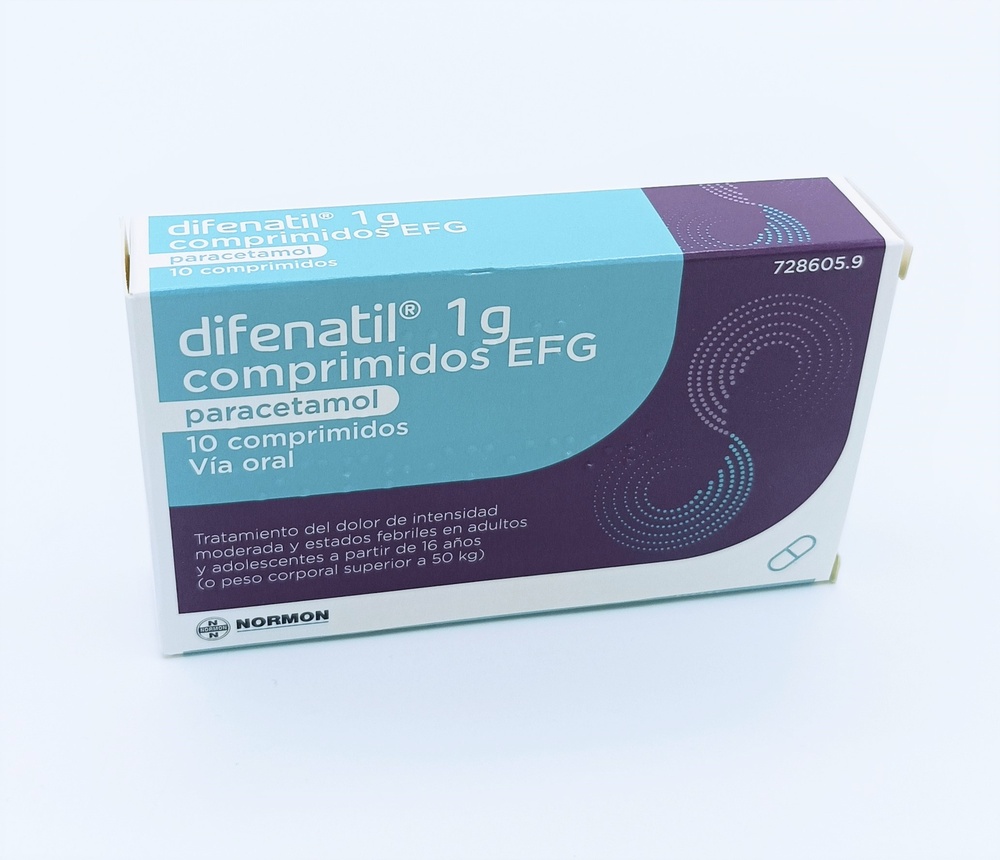

DIFENATIL 1 g TABLETS

Ask a doctor about a prescription for DIFENATIL 1 g TABLETS

How to use DIFENATIL 1 g TABLETS
Introduction
Package Leaflet: Information for the User
Difenatil®1 g Tablets
Paracetamol
Read the entire package leaflet carefully before starting to take this medication, as it contains important information for you.
Follow the administration instructions for the medication contained in this package leaflet or as indicated by your doctor, pharmacist, or nurse.
This medication can be purchased without a prescription. Nevertheless, to obtain the best results, it should be used with caution.
- Keep this package leaflet, as you may need to read it again.
- If you need advice or more information, consult your pharmacist.
- If you experience side effects, consult your doctor, pharmacist, or nurse, even if they are side effects not listed in this package leaflet. See section 4.
- You should consult your doctor if the fever worsens or persists after 3 days of treatment or the pain lasts for more than 5 days.
Contents of the Package Leaflet
- What Difenatil is and what it is used for
- What you need to know before taking Difenatil
- How to take Difenatil
- Possible side effects
- Storage of Difenatil
- Package Contents and Additional Information
1. What Difenatil is and what it is used for
Difenatil contains paracetamol as the active ingredient. Paracetamol belongs to the group of medications called analgesics and antipyretics.
Paracetamol is used for the treatment of moderate-intensity pain and febrile states in adults and adolescents over 16 years old (or with a body weight over 50 kg).
2. What you need to know before taking Difenatil
Do not take Difenatil
- If you are allergic (hypersensitive) to paracetamol or any of the other components of this medication (listed in section 6).
Warnings and Precautions
Consult your doctor or pharmacist before starting to take Difenatil.
- Do not take more medication than recommended in section 3. How to take Difenatil.
- Avoid simultaneous use of this medication with other medications containing paracetamol, such as medications for flu and colds, as high doses can lead to liver damage. Do not use more than one medication containing paracetamol without consulting your doctor.
- In patients with asthma sensitive to acetylsalicylic acid, consult your doctor before taking this medication.
- If you have kidney, liver, heart, or lung disease, or anemia (reduced hemoglobin levels in the blood), consult your doctor before taking this medication.
- When being treated with medication for epilepsy, consult your doctor before taking this medication, as the efficacy of paracetamol may be reduced and hepatotoxicity increased, especially with high doses of paracetamol.
- In chronic alcoholics, do not take more than 2 grams of paracetamol in 24 hours.
- If the pain persists for more than 5 days, the fever for more than 3 days, or the pain or fever worsen or other symptoms appear, consult your doctor and reevaluate the clinical situation.
- In adolescents under 16 years old, consult your doctor or pharmacist, as there are other presentations with doses suitable for this group of patients.
During treatment with Difenatil, immediately inform your doctor:
If you have severe illnesses, such as severe renal insufficiency or sepsis (when bacteria and their toxins circulate in the blood, causing organ damage), or if you have malnutrition, chronic alcoholism, or are also taking flucloxacillin (an antibiotic). A severe disease called metabolic acidosis (an anomaly in blood and fluids) has been reported in patients in these situations when paracetamol is used at regular doses for an extended period or when paracetamol is taken with flucloxacillin. Symptoms of metabolic acidosis may include: severe respiratory distress with deep and rapid breathing, drowsiness, feeling of discomfort (nausea) and vomiting.
Other Medications and Difenatil
Inform your doctor or pharmacist if you are using or have recently used any other medication.
Paracetamol may interact with the following medications:
- Medications to prevent blood clots: Oral anticoagulants (acenocoumarol, warfarin).
- Medications for treating epilepsy: Antiepileptics (lamotrigine, phenytoin, or other hydantoins, phenobarbital, methylphenobarbital, primidone, carbamazepine).
- Medications for treating tuberculosis: (isoniazid, rifampicin).
- Medications for treating depression and seizures: Barbiturates (used as hypnotics, sedatives, and anticonvulsants).
- Medications to lower cholesterol levels in the blood: (cholestyramine)
- Medications used to increase urine elimination (loop diuretics such as furosemide).
- Medications used to treat gout (probenecid and sulfinpyrazone).
- Medications used to prevent nausea and vomiting: Metoclopramide and domperidone.
- Medications used to treat high blood pressure and heart rhythm disorders (arrhythmias): Propranolol.
Inform your doctor or pharmacist if you are taking:
- Flucloxacillin (antibiotic), due to a serious risk of blood and fluid anomaly (called metabolic acidosis) that requires urgent treatment (see section 2).
Do not use with other analgesics (pain-relieving medications) without consulting your doctor.
As a general rule for any medication, it is recommended to systematically inform your doctor or pharmacist if you are being treated with another medication. In the case of treatment with oral anticoagulants, it can be administered occasionally as the analgesic of choice.
Interference with Analytical Tests:
If you are going to have any analytical tests (including blood tests, urine tests, skin tests using allergens, etc.), inform your doctor that you are taking/using this medication, as it may alter the results of these tests.
Taking Difenatil with Food, Beverages, and Alcohol
The use of paracetamol in patients who habitually consume alcohol (3 or more alcoholic beverages: beer, wine, liquor, etc. per day) may cause liver damage.
Taking this medication with food does not affect its efficacy.
Pregnancy and Breastfeeding
If you are pregnant or breastfeeding, think you may be pregnant, or plan to become pregnant, consult your doctor before taking this medication.
If necessary, this medication can be used during pregnancy. You should use the lowest possible dose that reduces pain or fever and use it for the shortest possible time. Contact your doctor if the pain or fever does not decrease or if you need to take the medication more frequently.
Small amounts of paracetamol may appear in breast milk; therefore, it is recommended that you consult your doctor or pharmacist before taking this medication.
Driving and Using Machines
The influence of paracetamol on the ability to drive and use machines is negligible or nonexistent.
This medication contains less than 1 mmol of sodium (23 mg) per tablet; it is essentially "sodium-free".
3. How to Take Difenatil
Follow these instructions unless your doctor has given you different instructions.
Remember to take your medication. Paracetamol should be taken orally.
The normal dose is:
Adults and adolescents over 16 years old: the usual dose is 1 tablet (1 gram of paracetamol) 3 times a day. The doses should be spaced at least 4 hours apart. Do not take more than 3 grams (3 tablets) in 24 hours.
Avoid using high daily doses of paracetamol for prolonged periods, as this increases the risk of adverse effects such as liver damage.
If the pain persists for more than 5 days, the fever for more than 3 days, or the pain or fever worsen or other symptoms appear, stop the treatment and consult your doctor.
Patient with liver disease: before taking this medication, they must consult their doctor. They should take the prescribed amount of medication with a minimum interval of 8 hours between each dose.
Do not take more than 2 tablets of paracetamol in 24 hours, divided into 2 doses.
Patient with kidney disease: before taking this medication, they must consult their doctor. Take a maximum of 500 mg per dose.
Due to the dose, 1 gram of paracetamol, it is not indicated for this group of patients.
Elderly patients: should consult their doctor.
Use in children and adolescents: Do not use in children and adolescents under 16 years old.
If the effect of paracetamol is deemed too strong or too weak, inform your doctor or pharmacist. When doses lower than 1 gram of paracetamol per dose are required, other presentations of paracetamol should be used that adapt to the required dosage.
If You Take More Difenatil Than You Should
Consult your doctor or pharmacist immediately.
Symptoms of overdose may include: dizziness, vomiting, loss of appetite, yellowing of the skin and eyes (jaundice), and abdominal pain.
If you have ingested an overdose, go to a medical center immediately, even if you do not notice symptoms, as they often do not appear until 3 days after ingestion, even in cases of severe poisoning.
Treatment of overdose is more effective if started within 4 hours of taking the medication.
Patient being treated with barbiturates or chronic alcoholics may be more susceptible to the toxicity of a paracetamol overdose.
In case of overdose or accidental ingestion, go to a medical center or call the Toxicology Information Service (telephone 91 562 04 20), indicating the medication and the amount ingested.
If You Forget to Take Difenatil
Do not take a double dose to make up for forgotten doses; simply take the forgotten dose when you remember, taking the next doses with the indicated interval (at least 4 hours).
4. Possible Side Effects
Like all medications, this medication can have side effects, although not everyone experiences them.
Rare side effects that may occur (between 1 and 10 in 10,000 people) are: discomfort, low blood pressure (hypotension), and increased transaminase levels in the blood.
Very rare side effects that may occur (in less than 1 in 10,000 people) are: kidney disease, cloudy urine, allergic dermatitis (skin rash), jaundice (yellowing of the skin), blood disorders (agranulocytosis, leukopenia, neutropenia, hemolytic anemia), and hypoglycemia (low blood sugar). Very rare cases of severe skin reactions have been reported.
Paracetamol can damage the liver when taken in high doses or for prolonged treatments.
Frequency not known (cannot be estimated from available data): A severe disease that can make the blood more acidic (called metabolic acidosis) in patients with severe disease using paracetamol (see section 2).
Reporting of Side Effects
If you experience any side effects, consult your doctor or pharmacist, even if they are possible side effects not listed in this package leaflet. You can also report them directly through the Spanish Pharmacovigilance System for Human Use Medications: https://www.notificaram.es. By reporting side effects, you can contribute to providing more information on the safety of this medication.
5. Storage of Difenatil
Keep this medication out of sight and reach of children.
This medication does not require special storage conditions.
Do not use this medication after the expiration date shown on the packaging after CAD. The expiration date is the last day of the month indicated.
Medications should not be disposed of through wastewater or household waste. Deposit the packaging and medications you no longer need at the SIGRE Point in the pharmacy. Ask your pharmacist how to dispose of the packaging and medications you no longer need. This will help protect the environment.
6. Package Contents and Additional Information
Composition of Difenatil
- The active ingredient is paracetamol. Each tablet contains 1 gram of paracetamol.
- The other components (excipients) are potato starch glycolate (Type A), purified water, pregelatinized corn starch, povidone K30 (E-1201), stearic acid (E-570), and crospovidone (E-1202).
Appearance of the Product and Package Contents
Difenatil is presented in tablets for oral administration.
The tablets are oblong, biconvex, white, with a score line on one face and marked with PC on the other face. The tablet can be divided into two equal halves.
In packages of 10 tablets, packaged in PVC/PVDC/Aluminum blisters.
Marketing Authorization Holder
LABORATORIOS NORMON, S.A.
Ronda de Valdecarrizo, 6
28760 Tres Cantos – Madrid
(SPAIN)
Manufacturer
Galenicum Health, S.L.U.
Sant Gabriel, 50,
Esplugues de Llobregat, 08950,
Barcelona – Spain
or
SAG Manufacturing S.L.U
Crta. N-I, Km 36
28750 San Agustin de Guadalix,
Madrid – Spain
Date of the Last Revision of this Package Leaflet:February 2025
Detailed and updated information on this medication is available on the website of the Spanish Agency for Medicines and Health Products (AEMPS) http://www.aemps.gob.es/
- Country of registration
- Active substance
- Prescription requiredNo
- Manufacturer
- This information is for reference only and does not constitute medical advice. Always consult a licensed doctor before taking any medication. Oladoctor is not responsible for medical decisions based on this content.
- Alternatives to DIFENATIL 1 g TABLETSDosage form: TABLET, 1 gActive substance: paracetamolManufacturer: Uxa Farma S.A.Prescription requiredDosage form: TABLET, 1 gActive substance: paracetamolManufacturer: Laboratorios Cinfa S.A.Prescription not requiredDosage form: TABLET, 1 gActive substance: paracetamolManufacturer: Laboratorios Cinfa S.A.Prescription not required
Alternatives to DIFENATIL 1 g TABLETS in other countries
The best alternatives with the same active ingredient and therapeutic effect.
Alternative to DIFENATIL 1 g TABLETS in Poland
Alternative to DIFENATIL 1 g TABLETS in Ukraine
Online doctors for DIFENATIL 1 g TABLETS
Discuss dosage, side effects, interactions, contraindications, and prescription renewal for DIFENATIL 1 g TABLETS – subject to medical assessment and local rules.















